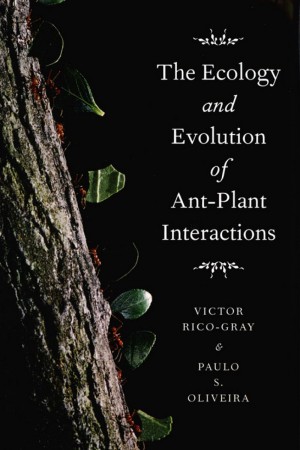The ecology and evolution of ant-plant interactions

| Auteurs |
|
| Éditeurs |
|
| Parution | 15/07/2007 |
| Pages | 331 |
| Catégorie |
|
| Langue |
|
Présentation
Ants are probably the most dominant insect group on Earth, representing ten to fifteen percent of animal biomass in terrestrial ecosystems. Flowering plants, meanwhile, owe their evolutionary success to an array of interspecific interactions—such as pollination, seed dispersal, and herbivory—that have helped to shape their great diversity. The ecology and evolution of ant-plant interactions brings together findings from the scientific literature on the coevolution of ants and plants to provide a better understanding of the unparalleled success of these two remarkable groups, of interspecific interactions in general, and ultimately of terrestrial biological communities.
The ecology and evolution of ant-plant interactions synthesizes the dynamics of ant-plant interactions, including the sources of variation in their outcomes. Victor Rico-Gray and Paulo S. Oliveira capture both the emerging appreciation of the importance of these interactions within ecosystems and the developing approaches that place studies of these interactions into a broader ecological and evolutionary context. The collaboration of two internationally renowned scientists, The ecology and evolution of ant-plant interactions will become a standard reference for understanding the complex interactions between these two taxa.
Sommaire
- Contents
- Preface
- Chapter 1. Ant-Plant Interactions
- The Origin and Early Evolution of Ant-Plant Associations
- Phylogenetic Associations
- A Brief History of the Associations
- Coevolution and Interspecific Interactions
- Chapter 2. Antagonistic Interactions: Leaf-Cutting and Seed-Harvesting Ants
- Leaf-Cutting Ants (Grazing)
- Seed-Harvesting Ants (Predation)
- Chapter 3. Mutualism from Antagonism: Ants as Primary Seed-Dispersers
- The Reward: Elaiosomes
- Seed Dispersal by Ants
- Myrmecochory: Distribution and Significance Worldwide
- Conclusion
- Appendix 3.1. Myrmecochory in Eastern North America, Japan, and Europe
- Appendix 3.2. Myrmecochory in Australia and South Africa
- Appendix 3.3. Myrmecochory in the Neotropics
- Chapter 4. Mutualism from Opportunism: Ants as Secondary Seed-Dispersers
- The Reward: Fallen Fleshy Diaspores
- Diaspore Attributes and Patterns of Ant Attendance
- Ant Effects on Seeds and Seedlings
- Directed Dispersal of Seeds by Ponerine Ants
- Prospect
- Chapter 5. Mutualism from Antagonism: Ants and Flowers
- Pollination by Ants
- Discouragement of Floral Visits by Ants
- Appendix 5.1. Plant Species in Which Ant Pollination Has Been Demonstrated
- Chapter 6. Antagonism and Mutualism: Direct Interactions
- The Pseudomyrmex-Acacia Association
- Ants, Plants, and Food Bodies
- Ant-Inhabited Plants Offering No Direct Food Rewards
- Ants, Plants, and Extrafloral Nectaries
- Plant Defensive Strategies and Induced Responses
- The Nature of the Associations and the Importance of Conditionality
- Topics for Future Consideration
- Appendix 6.1. Flowering Plants That Maintain a Nonsymbiotic Relationship with Ants
- Chapter 7. Antagonism and Mutualism: Indirect Interactions
- Ants, Plants, and Hemipterans
- Variable Outcomes in Ant-Hemipteran Systems
- The Effect of Ant-Hemiptera Interactions on Host Plants
- Ant-Hemiptera Associations and the Evolution of Extrafloral Nectaries
- Chapter 8. Nutrition of Plants by Ant Mutualists: Life History of Ant-Fed Plants and Ant-Garden
- Systems
- Ant-Fed Plants
- Ant Gardens
- Conclusion
- Appendix 8.1. Ant-Fed Plants That Absorb Nutrients from Ant Debris
- Chapter 9. Canopy-Dwelling Ants, Plant and Insect Exudates, and Ant Mosaics
- Canopy Ants: Main Features and Trophic Role
- The Competitive Environment
- Ant Mosaics
- Plant and Insect Exudates and Ant Community Structure
- The Effect of Trophobiont Tenders on Associated Herbivores and on the Host Plant
- Chapter 10. Variation in Ant-Plant Interactions
- Temporal Variation
- Spatial Variation
- Appendix 10.1. Plants with Extrafloral Nectaries
- Appendix 10.2. Ant Species Using Plant-Derived Food Resources
- Chapter 11. Ant-Plant Interactions in Agriculture
- Agricultural Systems, Herbivores, and Ants
- Ants as Biological Control Agents
- Case Studies
- Biological Control and Interspecific Interactions
- Chapter 12. Overview and Perspectives
- Literature Cited
- Index
- 13 lectures
Bibliothèque
